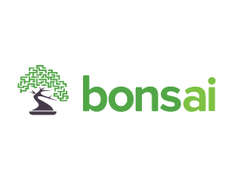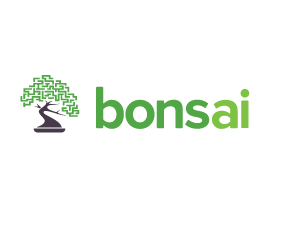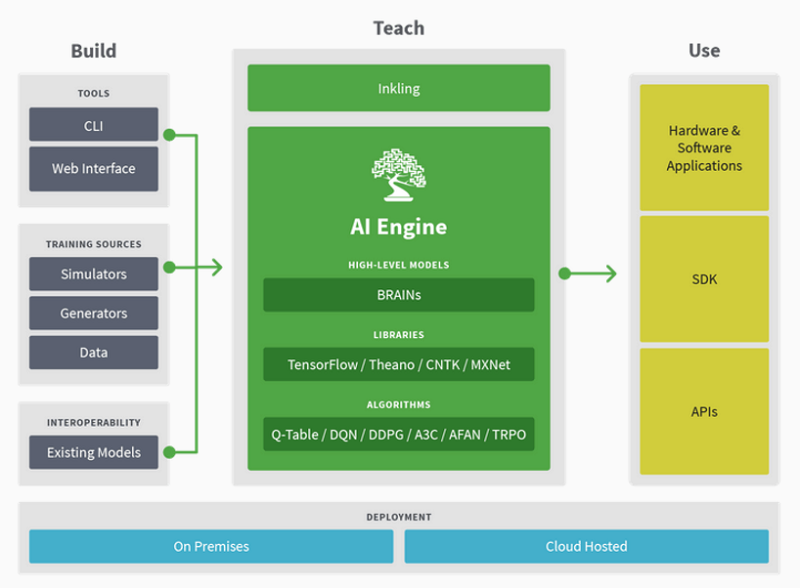
Aug. 14, 2017
By: Michael Feldman
One of the biggest impediments to more widespread use of AI is the lack of developer expertise in machine learning software. Bonsai, a startup based in Berkeley, California, is looking to change that in a big way by offering a platform that abstracts away a lot of the low-level nuts and bolts that makes machine learning such a daunting challenge for businesses.
 Bonsai, both the company and the software platform of the same name, is aimed at businesses looking to inject AI into an industrial setting. That covers everything from robotics and autonomous cars to supply chain logistics and environmental control. Lacking the machine learning expertise of the Googles and Baidus of the world, these businesses need to find a way to incorporate the technology into their own products and services. And that’s the driving principle behind Bonsai.
Bonsai, both the company and the software platform of the same name, is aimed at businesses looking to inject AI into an industrial setting. That covers everything from robotics and autonomous cars to supply chain logistics and environmental control. Lacking the machine learning expertise of the Googles and Baidus of the world, these businesses need to find a way to incorporate the technology into their own products and services. And that’s the driving principle behind Bonsai.
The company is the brainchild of Mark Hammond, who launched the startup in 2014 and now fills the role of chief executive officer. Hammond began his computer career while he was still in high school, working as an intern, and later as a contractor, for Microsoft. His passion in AI and neuroscience led him to study computation and neural systems at Caltech. After graduating, Hammond was involved in a series of computer startups, both within the AI space and outside it.
Bonsai was inspired by the realization that making machine learning algorithms smarter was not the crux of the problem, at least outside the big AI research labs. “The insight was that no matter how smart we made the learning algorithms, by design, they have to learn, which means we have to teach them,” Hammond told TOP500 news. “And relatively little attention was being paid to how to teach the algorithms. But to me, that was the bridge to how we can make the technology accessible to people who aren’t experts in the mechanics of how machine learning works.”
The goal was to make the technology friendly to subject domain experts and programmers with traditional development backgrounds. Make no mistake, you still need some level of programming expertise to use the platform, but according to Hammond, knowing the low-level elements of AI programming is not required. That opens up the field to people like mechanical engineers, chemical engineers, and urban planners, at least those with a reasonable amount of programming under their belt, or access to someone who possesses it.
Bonsai abstracts away the much of the detail work involved in machine learning, as well as the utilization of the deployment and training infrastructure. Hammond likens this to the way that database languages abstract away the low-level mechanics of how you manipulate data. For example, a language like SQL enables users to specify the structure of data and the kinds of questions you wanted to ask of it, which lets database managers operate much closer to the business problem they want to solve. They didn’t have to concern themselves with the tree algorithm used to access the data or how many machines in the cluster were being used.
“We do the same kind of thing for AI,” said Hammond. Bonsai is built on top of TensorFlow, an open-source machine learning framework, popularized by Google. By up-leveling the interface, users don’t need to know about the underlying details – things like which machine learning algorithms are to be used, what the neural network topology should look like, what all the hyper-parameters should be, or how the processing is actually distributed across multiple machines.
To do this, they created a programming language, called Inkling, which specifically focuses on the abstraction of machine teaching. Users codify what they are trying to teach the system and specify a plan on how to teach it. This “curriculum” tells Inkling how to map a set of lessons onto the training algorithms. If you’re doing a reinforcement learning problem, you attach third-party simulators to the training sources, which the platform manages for you.
You begin by defining the core concepts of what you want to teach. Concepts can be skills or facts about the world, such as perceptions. For each concept, you need to specify a series of lessons on how that is taught. For a simple robotic system, you might have a handful of concepts, while an autonomous vehicle would have hundreds.
 Source: Bonsai
Source: Bonsai
In the case of a robotic armature that picks objects up and moves them somewhere else, the relevant concepts are about different kinds of grasps, orientation of parts, and so on. For grasping, you typically begin teaching with the part in a fixed location, with a known orientation, and with the mechanical arm close to the part. In subsequent lessons, you would relax one of those constraints, building up more complex behavior iteratively.
Typically, a simulator such as Gazebo or RobotSudio would be attached to drive the teaching. Some of these simulator interfaces are already built into Bonsai, but if that’s not the case, you can use the API to glue a new simulator to the platform. For things like image recognition, you don’t usually need simulation, just a dataset, and in those situations, that's what gets injected into the training workflow.
The company claims they can achieve a ten-fold reduction in the size of the code needed to develop a typical machine learning application. But according to Hammond, Bonsai can deliver an even greater reduction in development time, since deployment and other downstream issues are handled by the platform as well. The order of magnitude increase in developer productivity would seem to be Bonsai’s main selling point, and a highly attractive one at that should the technology prove out.
Hammond says the platform will be licensed based on training cycles, with annual fees typically running anywhere from $50K to $500K, depending on the extent of those cycles. In some circumstances, you’ll need a runtime license if Bonsai is required to execute on deployed hardware where the model is being used for production (inferencing). But, according to Hammond, the primary cost will be the annual licensing fee.
All of that will go into effect once Bonsai becomes generally available. Right now, the company is its focused on its early access program, which was launched in May and has attracted a number of businesses working on industrial AI projects. Siemens, which is also a Bonsai investor, is the only early user that has been publicly revealed. They are purportedly using the platform to incorporate intelligence into their manufacturing equipment and infrastructure.
Hammond says once they get some solid proof points in place with these initial customers, they will release the product for general availability. He’s hoping that will happen sometime in Q4 2017 or Q1 2018, but they are not going to rush it to market. “We will make that call once we achieve the early access objectives and we’re ready for that milestone,” said Hammond.
